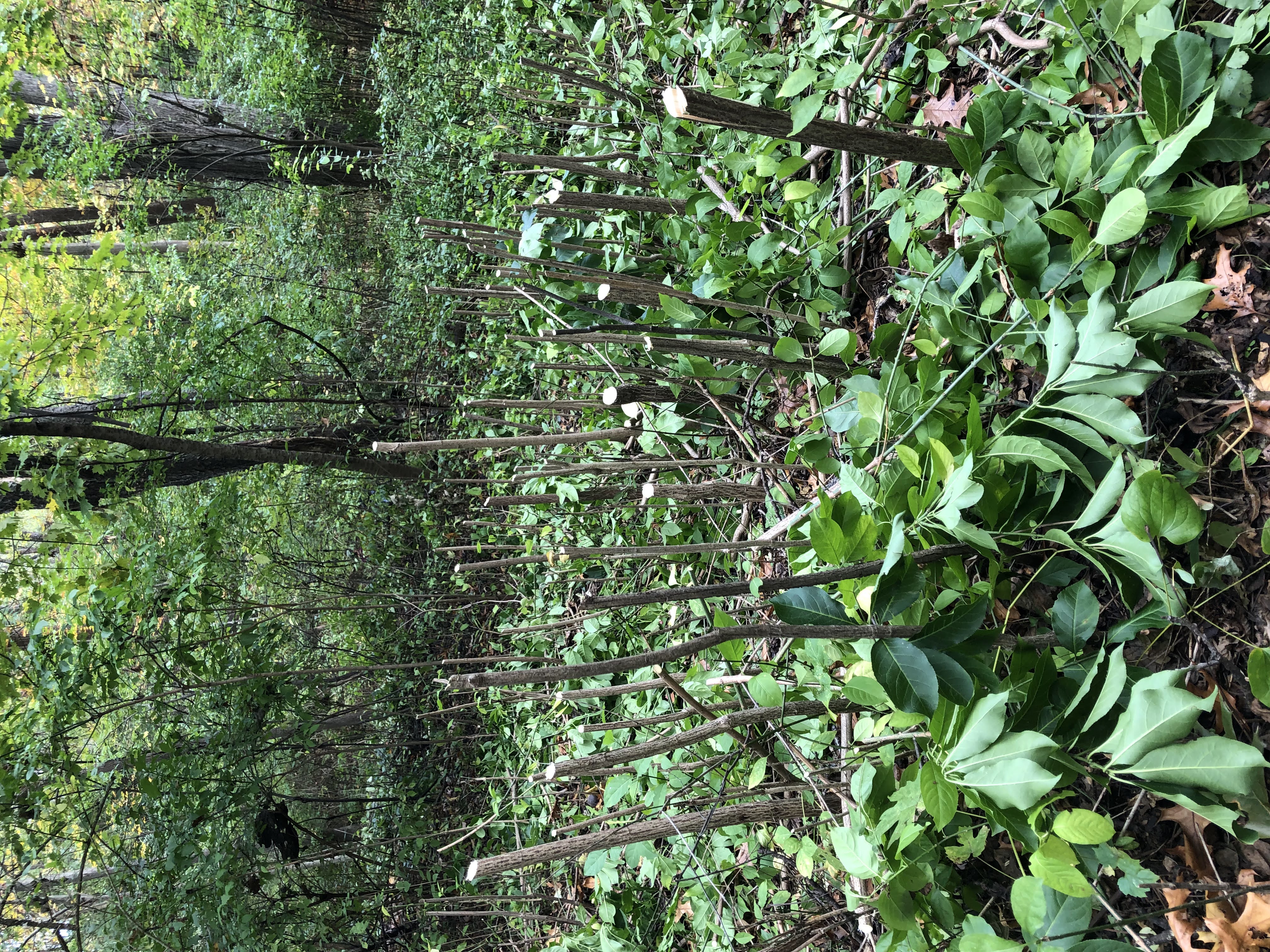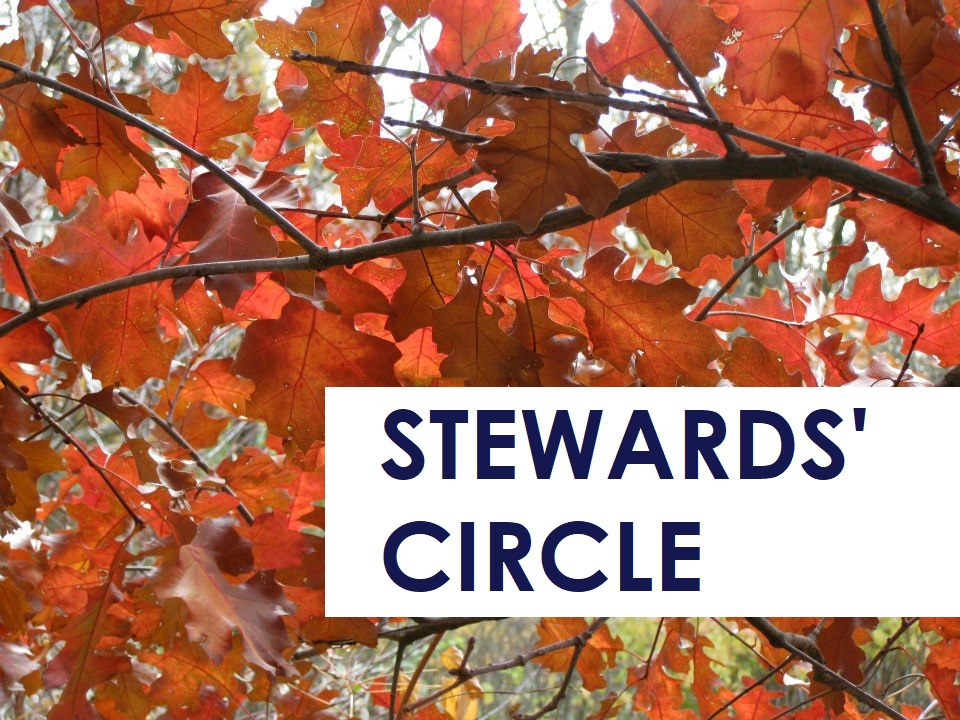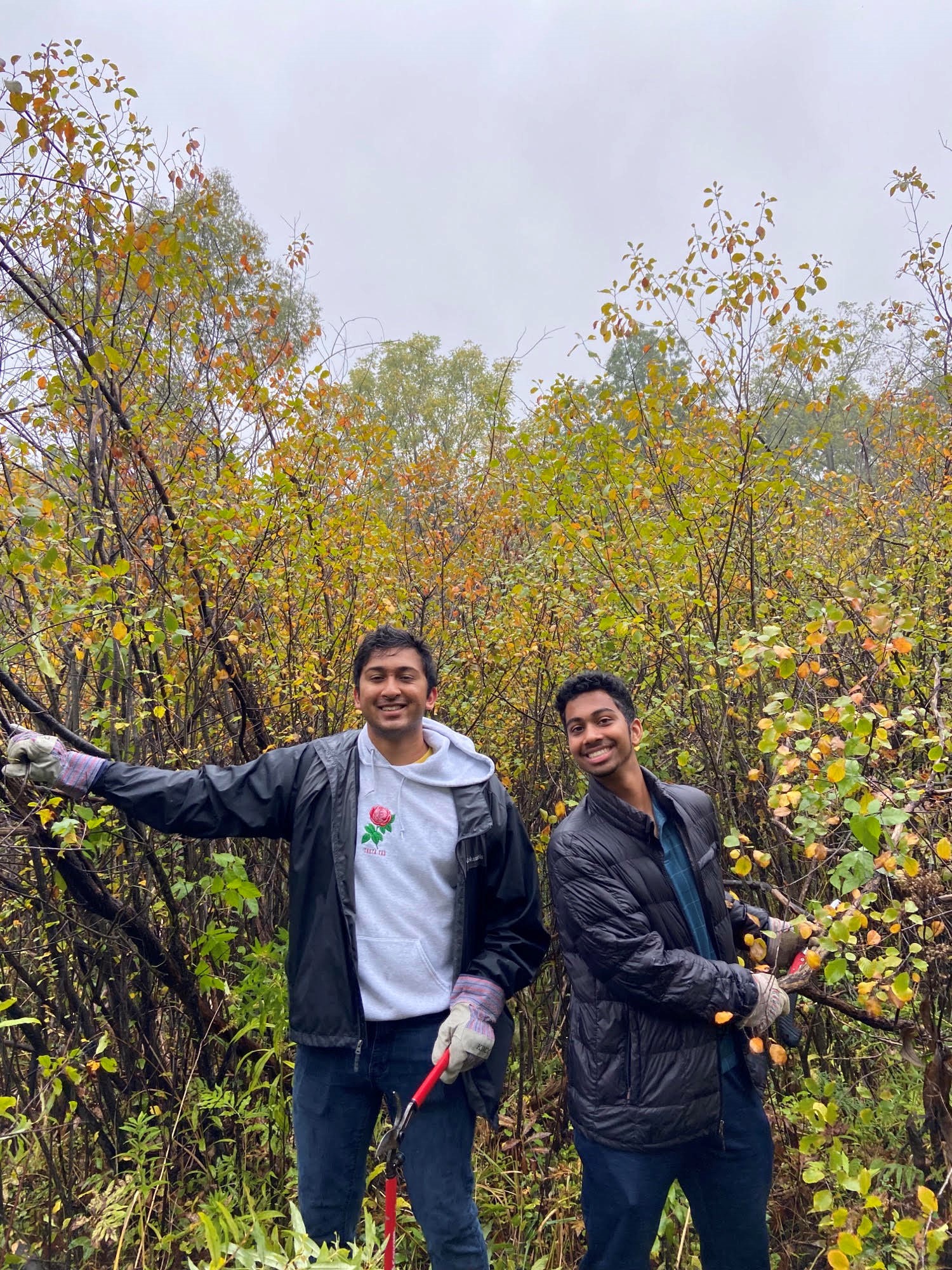Renée Hytinen,
NAP Communications and Special Events
The Stewards' Circle currently meets 5:30-6:30 p.m. on the second Tuesday of each month at Veteran's Memorial Park facility meeting room, followed by a happy hour, 6:30-7:30 p.m., at HOMES Brewery. No registration needed, just show up!
“Everyone brought a valued perspective to the circle, whether they were new to working with native plants or had many years of experience. No questions were too simple or were off the table."
In 1998, Lisa Brush and a handful of colleagues met to talk quietly in a bagel shop. In the second-floor seating area of the Bruegger's Bagels on North University, at 7:30 a.m., they set out to “create a space that is open to folks who would like to connect to talk about how we 'do' stewardship. To create community and share knowledge among people who are managing land," said Brush, director of The Stewardship Network (TSN). They called it the Stewards' Circle, and it worked so well that the Circle has remained active for 25 years.
The format was uncomplicated: a group discussion about a stewardship topic, everyone welcome. Land managers, volunteer stewards, professional restorationists, land owners, home owners, environmental science students, conservation technicians – everyone has a place at the table, from the experts to those people who are brand new to restoration work.
One of Brush's colleagues at the early meetings was Bob Grese, now Professor Emeritus, School for Environment and Sustainability at the University of Michigan. “I remember trying to create an atmosphere and place where people could come learn and share about their experiences in ecological restoration and native plant gardening where they would feel supported," said Grese. “Everyone brought a valued perspective to the Circle, whether they were new to working with native plants or had many years of experience. No questions were too simple or were off the table,"
In 2021, the Circle has come back around to essentially the same format as in the beginning – an hour-long conversation around a stewardship question or topic, in-person, open to anyone interested, at a location where most anyone can join. The Circle now takes place at 5:30 p.m., at the meeting room at Veteran's Memorial Park facility (or when the weather is cooperative, outside in front of the building).
The location change has removed a couple of barriers that coordinators couldn't address at the previous location. For one, the Veteran's Memorial Park facility has tons of free parking – something North University hasn't been able to offer since before anyone can remember. Most importantly, the facility is fully accessible – there are no steps or stairs on the way to the meeting space.
A new place and time are indeed major changes, but the real news about the Stewards' Circle in 2021 is the invitation to join a social hour after the meeting. “Everyone is looking to just connect again, to be together, to connect with community," said Tina Stephens, Volunteer and Outreach Coordinator for NAP. When the meeting concludes at 6:30 p.m., any interested folks can go directly across Jackson Road to HOMES Brewery for happy hour. All are welcome – you don't have to attend one to attend the other – happy hour is intended for building and strengthening the relationships that make the Stewards' Circle so effective.
“This is the beauty of The Stewardship Network," said Jason Frenzel, Volunteer & Stewardship Coordinator at Huron River Watershed Council. “This is what it does. It creates partnership and collaboration that bring a higher-level mutual benefit." As TSN has consistently demonstrated through its work in the years since launching the Circle, networking is not just for professionals - it can be a tool for anyone who wants to engage with community. As humans, we are all facing the same global issues related to climate change, but perhaps more relevant to those who want to make change is that we are all facing the same local issues. It doesn't matter if you're managing acres for Washtenaw County, caring for your urban front yard in Pittsfield Township, or restoring a small piece of waterfront in Dexter – you're going to face mostly the same challenges as others in the area.
Both Stephens and Brush see the value in encouraging people who are new to the professional restoration field to attend and go so far as try to anticipate the barriers those folks might encounter. Supervisors may have a hard time seeing the value of letting their employees attend the meetings, and as Brush said: “Let's go talk to those supervisors!" People do often attend circles as a means for professional development," said Stephens, “I've seen people attending as a way of networking. It can be part of a larger strategy of getting into the industry. Knowing people goes a long way. Meeting them in an informal setting helps with engaging in a professional setting."
**
“When people get together to share about nature, they can create knowledge together without a background in that topic."
The City of Ann Arbor's Natural Area Preservation unit (NAP) was just five years old in 1998 when Dave Borneman became one of the original Circle regulars– with Brush, Grese, Erin Lavender, and Ray Fahlsing, now the Stewardship Unit Manager of the Michigan DNR Parks and Recreation Division. At the time, “NAP was an information dispenser. There was nobody else to ask questions
to," said Borneman, NAP manager. For NAP's volunteer park stewards: “The Stewards' Circle helped to give people another place to learn, and connect outside of NAP, to give them access to the larger restoration field."
In those early days, the small group of regulars committed to come every month. “We thought it was important to come together and have a face-to-face discussion," said Borneman. As for NAP's involvement as an agency, there were important considerations, “NAP was the big player here in the beginning, [we didn't] want to dominate the conversation, or overwhelm the room with just NAP people." At the same time, NAP has sometimes helped keep the Circle's momentum, “NAP has a deep enough bench to keep it going when individuals aren't able to make it."
The location of Bruegger's Bagels was chosen pretty quickly as it fit most of the needs of the Circle, Brush said, “we knew we needed a place where anyone could feel comfortable – not too public, not too small, with a dedicated space to take over, the option to buy food while not
requiring a purchase for entry." The meeting space within Bruegger's is upstairs from the front counter, and Brush remembers Bruegger's staff “agreed to turn the music off and allowed us to post a little welcome sign (in marker) at the bottom of the stairs to direct people to the meeting. Early morning seemed the most straightforward choice for the timing, one benefit being that nobody's on the clock yet at 7:30 a.m." Attending during a lunch hour was too disruptive to the workday for most people and evenings had their own challenges.
“This was before the internet was big!" Brush said. “We just put an ad in the Observer, and had no idea who [was] going to come!" Soon after the Stewards' Circle launched, TSN started publishing
The Ripple Effect – a newsletter and calendar of events for local stewards. “People wanted to know about each other's workdays, and there's a lot to be said for sharing opportunities. Working with volunteers isn't a yours or mine game," said Brush. A lot of the published events were hosted by local agencies and organizations who understood that having one big pool of interested local volunteers is better than keeping eager and willing workers siloed among different groups.
**
Professional restorationists are often limited to field work that is conventionally considered efficient – they may, for example, work for agencies with limited staff time, or could be beholden to board oversight – and volunteer stewards and homeowners have different constraints. When they all get together to compare notes, those perceived constraints start to fall away.
Among those groups recruiting volunteers was NAP, and by 2005, NAP was handling coordination and facilitation of the Stewards' Circle as part of NAP's membership in the Huron-Arbor Cluster of The Stewardship Network. Serving the Greater Washtenaw area, the Huron-Arbor Cluster is one of TSN's “member communities" – localized stewardship initiatives, supported and empowered by TSN “to convene and work towards common ecological goals in their communities."
The Huron-Arbor Cluster has two main areas of focus: 1) on the ground conservation action and planning, and 2) educating community members in conservation issues, techniques and other relevant topics. “We focus on local stewardship issues and plans to address those concerns through implemented action," reads the cluster's page on TSN's website. “We provide unique educational opportunities through events, workshops, activities and online networking to share ideas, information, skills and resources to enable local groups to increase their capacity to care for local land and water."
Jason Frenzel was the first NAP staffer to manage the Stewards' Circle and is currently a co-coordinator of the Huron-Arbor Cluster. He understood right away the value of this type of gathering. “When people get together to share about nature, they can create knowledge together without a background in that topic," said Frenzel. Cultivating a group discussion where all voices and all experiences are weighted equally is not an easy task. “It was an important learning process for me to facilitate equal footing. In our culture we are not taught this skill very well. Equitable interaction has to be learned."
The next NAP staffer to handle coordination of The Stewards' Circle was Tina Stephens, who found that changes to programming were needed to help support the quality of the conversation. “Questions were being asked, but not answered," observed Stephens. She started inviting guests to join – content knowledge providers who easily folded into the conversation, who could also answer hard questions if they came up. This “guest" model remained until the meetings had to be moved online in 2020. “At first," said Stephens, “guests fit back into the discussion group, but it turned slowly into presentations. Then COVID turned it into just presentations with Q&A, and we lost the discussion aspect." Attendance understandably began to drop off once meetings were moved online, and after a year of virtual meetings, it became clear that it was again time for a process of reflection and slight adjustment.
**
"Come as you are and be ready to explore new thoughts and perspectives. Whether you're new to the environmental field or seasoned veteran, there's something for everyone."
To Frenzel, anyone can be an avid nature watcher, anyone doing restoration work has the capacity to bring useful and enriching knowledge. “Every volunteer steward, or homeowner, or land owner, or professional who came to the circle, had experiences – like treating invasives, reintroducing native plants, identifying birds and butterflies – and because it was on their own property, or on land they helped work with, what they knew to work was always correct because it was their experience." Humans first “created the knowledge simply by observing the world. Avid nature watchers have created a wealth of understanding."
Professional restorationists are often limited to field work that is conventionally considered efficient – they may, for example, work for agencies with limited staff time, or could be beholden to board oversight – and volunteer stewards and homeowners have different constraints. When they all get together to compare notes, those perceived constraints start to fall away. “Decentralized non-hierarchical relationships allow people to come up with more solutions," said Frenzel.
“The experimentation and diversity of types of [restoration] attempts were eye-opening!" One such attempt that was brought to the group, Frenzel remembers, involved a 2-year commitment from a NAP Park Steward: “They wanted to remove a ton of buckthorn in a very low priority area. NAP let them know we wouldn't supply resources to that section of the park. The steward still wanted to tackle it (without being able to use chainsaws or herbicide), so they girdled a small forest of buckthorn. Then they went back every two-to-three weeks, for two years, and cut off re-sprouts – and they killed all of them! Then we were able to tell others that there are alternative methods of control. Without that volunteer, NAP – and others – wouldn't have been able to promote that tool as a resource. They proved that it's possible to remove a very large amount of buckthorn without chainsaws or herbicide. There are multiple solutions to whatever the restoration problem."
**
The Stewardship Network Conference creates space to “connect to share setbacks and successes; technological advancements and analytical techniques; diverse perspectives and artistic expressions as we collectively find the best ways to care for our land and water."
The Ripple Effect newsletter and calendar – no longer in print – is named for the phenomenon that aptly describes the impact of the Stewards' Circle. “It's the power of people talking quietly in a bagel shop," said Brush, where one conversation can shape and reshape perspectives and the knowledge shared will ripple outward to the rest of the community.
The ripple effect and the Circle are also models for a much larger discussion group of sorts; The Stewardship Network Conference creates space to “connect to share setbacks and successes; technological advancements and analytical techniques; diverse perspectives and artistic expressions as we collectively find the best ways to care for our land and water."
As described by TSN, “this interdisciplinary conference harnesses the power of the network to build bridges between knowledge, culture, and community in order to support the ecosystems around us that are continually threatened and changing." The conference, now celebrating 15 years, “include(s) topics such as restoring oak openings, heat islands, wild rice, community engagement, invasive species management, project case studies and an entire track on collaborative leadership."
Hundreds of “professionals, students, and volunteers from an array of environmental fields" will join the virtual conference being held January 26-28, 2022, for presentations, workshops, panels, interviews, virtual field trips, and networking opportunities." In past years, the conference had a single keynote speaker, however, this year, keynote speakers from the past 15 years of conferences have all been invited to return, so attendees in 2022 will be able to connect and share with a slew of leaders in collaborative conservation.
Notable returning voices include: Carolyn Finney, PhD, storyteller, author, and cultural geographer; Steve Apfelbaum, ecologist and restoration consultant; Dallas Goldtooth from the Indigenous Environmental Network.
Editor's note: Goldtooth is also a comedian and journalist, and this editor is something of a fan.
And lest you forget that you are a vital part of the community and have a place at the table, the conference “prides itself on cultivating a welcoming and accepting atmosphere. Come as you are and be ready to explore new thoughts and perspectives. Whether you're new to the environmental field or a seasoned veteran, there's something for everyone at our Network's annual gathering!"
NAP invites you to join us at one of the upcoming Stewards' Circles – always the second Tuesday of each month, and for the foreseeable future meeting at 5:30 p.m. at Veteran's Memorial Park facility meeting room. Some NAP staff and volunteers will also attend the conference – consider joining us!
Sincere thanks to The Stewardship Network for launching the program that has created so many ripples! NAP continues to learn and develop with the support of TSN, and we are grateful for the opportunities for collaboration and sharing that the relationship brings. Much appreciation to Lisa, Tina, Jason, and Dave for talking with me about the Stewards' Circle and TSN – what a treat to talk to the people who were there!
**********
 Freshly cut honeysuckle stumps at Miller Park from October's public workday.
Freshly cut honeysuckle stumps at Miller Park from October's public workday.
**********
NAPpennings

November Stewards' Circle
Tuesday, November 9, 2021, 5:30 – 6:30 p.m. (Followed by happy hour nearby!), Veterans Memorial Park Meeting Room
Introducing a whole new Stewards Circle! For the last 25 years, the Huron Arbor Cluster of the Stewardship Network has been gathering monthly, and for the past decade the group has met with a local expert to answer your questions; now it's time to flip the script! You are invited to join us at the newly renovated Veterans Memorial Park Meeting Room to share your experiences and learn from your peers. This month's topic: perils of working in nature “How have you successfully (or unsuccessfully) avoided stings and bites? What kinds of precautions do you take to avoid overwork, dehydration, and minor injury? What kind of close calls have you experienced that made you change the way you work outdoors?" After the discussion group, join us for a happy hour just up the street at HOMES Brewery to further connect with other land stewards!
**********

Students from UM Indian American Student Association cut shrubs at Barton Nature Area in October.
Thank you!
Many thanks to the groups who volunteered with NAP recently. We could not make such a difference without you!
Cub Scouts Pack 131
EMU Beta Alpha Psi - Accounting Club
